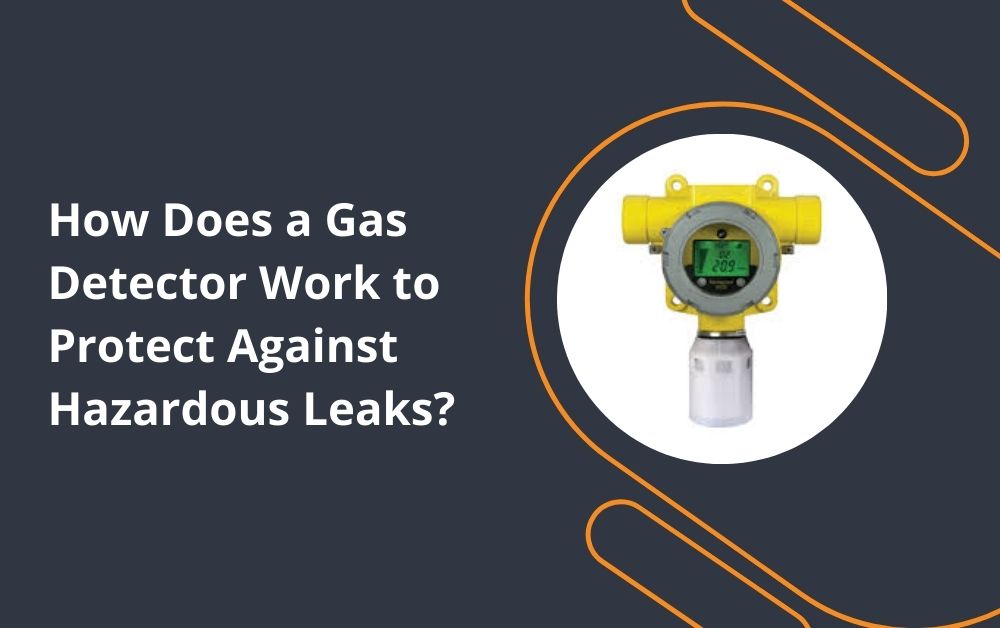Gas leaks can be dangerous, not only because they pose a serious risk of fire or explosion, but also because many gases are harmful or even deadly when inhaled. This is why gas detectors are crucial for ensuring safety in homes, businesses, and industrial environments. A gas detector is designed to sense the presence of hazardous gases in the air and alert people to take action before the situation becomes dangerous.
In this blog, we’ll explain how gas detectors work, the different types available, and why they are essential for protecting against hazardous gas leaks.
Understanding Gas Detectors
What Is a Gas Detector?
A gas detector is a safety device that monitors the air for the presence of harmful or combustible gases. When the device detects a gas leak, it triggers an alarm to warn people that immediate action is necessary. Gas detectors are commonly used in homes, commercial buildings, factories, and industrial facilities where gases are stored, produced, or used.
Why Are Gas Detectors Important?
Many gases are odorless and colorless, making it impossible to detect them without specialized equipment. A small gas leak, if unnoticed, can lead to severe health problems, explosions, or fires. Gas detectors provide an early warning system that can save lives, prevent accidents, and reduce the risk of property damage.
How Gas Detectors Work
The Basics of Gas Detection
Gas detectors work by continuously monitoring the air and measuring the concentration of specific gases. They are designed to detect hazardous gases like carbon monoxide (CO), methane (CH4), propane, hydrogen sulfide (H2S), and others. When the detector senses that the level of a dangerous gas has reached a critical threshold, it sends out an alert, typically in the form of a loud alarm or visual signal.
The Components of a Gas Detector
Most gas detectors consist of the following key components:
- Sensor: The sensor is the heart of the gas detector. It detects gas particles in the air and measures their concentration.
- Microcontroller: The microcontroller processes the data from the sensor and compares it to pre-programmed safety levels. If the gas concentration exceeds safe limits, it triggers an alarm.
- Alarm System: The alarm system, which can include sound, light, or both, alerts users to the presence of dangerous gas levels.
- Power Source: Gas detectors can be powered by batteries or connected to an electrical system, depending on the type of detector and its application.
Types of Sensors Used in Gas Detectors
Different gas detectors use various types of sensors to detect specific gases. Some of the most common types of sensors include:
1. Electrochemical Sensors
Electrochemical sensors are commonly used to detect toxic gases like carbon monoxide, hydrogen sulfide, and chlorine. They work by generating a small electrical current when a particular gas comes into contact with the sensor, indicating the presence and concentration of the gas.
2. Infrared Sensors
Infrared sensors are used to detect combustible gases, such as methane and propane. These sensors measure the absorption of infrared light by gas molecules. If the gas is present, it absorbs specific wavelengths of the light, allowing the sensor to determine the concentration of the gas.
3. Catalytic Bead Sensors
Catalytic bead sensors are often used in industrial settings to detect flammable gases. The sensor consists of a heated element that reacts with combustible gases, causing a change in temperature. This change is then measured to detect the presence of a flammable gas.
4. Semiconductor Sensors
Semiconductor sensors are used to detect gases like ammonia and hydrogen. These sensors work by detecting changes in electrical conductivity when exposed to a target gas. They are cost-effective and widely used in both industrial and residential gas detectors.
Types of Gas Detectors
1. Fixed Gas Detectors
Fixed gas detectors are installed in a permanent location and continuously monitor the air for the presence of harmful gases. They are typically used in industrial environments where gas leaks are more likely to occur, such as chemical plants, oil refineries, or factories. Fixed detectors are usually connected to a central alarm system that can alert workers or emergency personnel when dangerous gases are detected.
2. Portable Gas Detectors
Portable gas detectors are handheld devices that workers can carry with them to monitor gas levels in different areas. These are particularly useful for workers who need to move between locations where gas hazards may be present. Portable detectors are commonly used in industries like mining, oil and gas, and firefighting, where workers need real-time gas monitoring while on the job.
3. Single-Gas Detectors
As the name suggests, single-gas detectors are designed to detect only one type of gas. These detectors are useful in environments where the primary concern is a specific gas, such as carbon monoxide in homes or hydrogen sulfide in industrial plants.
4. Multi-Gas Detectors
Multi-gas detectors are capable of detecting multiple gases at the same time. These detectors are often used in industrial settings where there may be multiple gas hazards, such as confined spaces or chemical processing plants. They provide comprehensive monitoring of several gases, making them more versatile than single-gas detectors.
The Importance of Gas Detectors in Different Settings
1. Residential Homes
In homes, gas detectors are typically used to detect carbon monoxide and natural gas leaks. Carbon monoxide is a colorless, odorless gas that can be lethal in high concentrations. Having a gas detector in your home can provide peace of mind, knowing that your family is protected from these hidden dangers.
2. Commercial Buildings
Commercial buildings, such as restaurants, hotels, and offices, often use gas detectors to monitor for leaks of combustible gases like propane or natural gas. Gas detectors ensure that any leaks are detected quickly, reducing the risk of explosions or fires that could endanger occupants and damage property.
3. Industrial Facilities
In industrial environments, gas detectors are essential for protecting workers and preventing accidents. Facilities that handle chemicals, gases, or other hazardous materials rely on gas detectors to ensure safety. These detectors are critical in areas like oil refineries, chemical plants, and manufacturing sites, where gas leaks can lead to fires, explosions, or exposure to toxic substances.
Benefits of Gas Detectors
1. Early Detection of Gas Leaks
Gas detectors provide early warning of gas leaks, giving people time to evacuate the area and take corrective action before a situation becomes dangerous. This early detection is critical for preventing fires, explosions, and health risks caused by exposure to toxic gases.
2. Reducing Health Risks
Many gases, such as carbon monoxide, hydrogen sulfide, and chlorine, are harmful or deadly when inhaled. Gas detectors help reduce the health risks associated with these gases by providing timely alerts and allowing workers or residents to leave the area before their health is compromised.
3. Preventing Property Damage
Gas leaks can cause significant property damage if they result in a fire or explosion. Gas detectors can help prevent these incidents by identifying leaks early and allowing repairs to be made before any damage occurs.
4. Compliance with Safety Regulations
In many industries, the use of gas detectors is required by law to ensure the safety of workers and comply with regulations. Having the proper gas detection systems in place helps companies avoid fines, lawsuits, and other legal issues related to safety violations.
How to Choose the Right Gas Detector
1. Identify the Gases to Be Detected
The first step in choosing a gas detector is to identify the specific gases that need to be monitored. Different detectors are designed to detect different gases, so it’s important to select one that meets your needs.
2. Consider the Environment
The environment where the gas detector will be used is another important factor. In industrial settings, for example, you may need a detector that can handle extreme temperatures, humidity, or the presence of dust and chemicals. For homes, a basic carbon monoxide or natural gas detector may be sufficient.
3. Determine the Detection Range
Gas detectors have different detection ranges, which refer to the concentration of gas they can detect. Choose a detector with a range suitable for the environment you are monitoring. For high-risk areas, select detectors with lower detection thresholds to catch leaks early.
4. Look for Reliability and Certification
Make sure the gas detector you choose is reliable and certified by safety organizations, such as Underwriters Laboratories (UL) or the International Electrotechnical Commission (IEC). These certifications ensure that the detector meets industry safety standards and will perform as expected.
Conclusion
Gas detectors play a crucial role in protecting against hazardous leaks by providing early detection and alerting people to take action before a situation becomes dangerous. Whether you are safeguarding your home, business, or industrial facility, investing in reliable gas detectors is essential for ensuring the safety of people, property, and the environment.
By understanding how gas detectors work and selecting the right one for your specific needs, you can prevent accidents, reduce health risks, and protect your assets from the devastating consequences of gas leaks.
Note :- To read more articles visit on bioneerslive.




